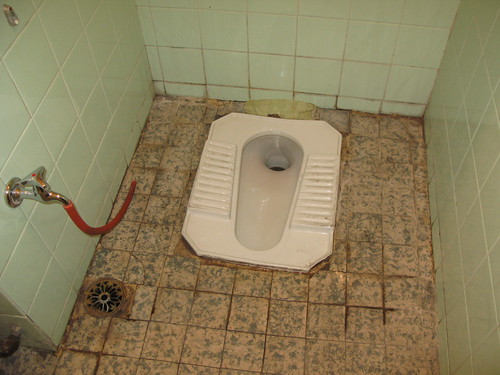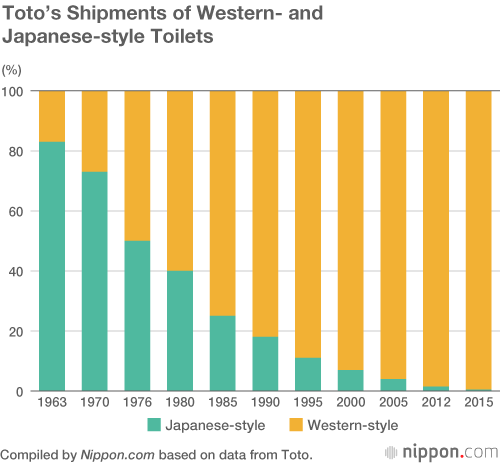- Forum
- categories
- Sanitation systems
- Toilets without urine diversion
- Please help me with a global survey: how common are squatting toilets in your country?
Please help me with a global survey: how common are squatting toilets in your country?
115k views
- zigazie
-
- A WASH Specialist who holds a Bsc in Health Promotion, Masters in Public Health (Health Promotion), Bill and Melinda Gates Foundation Scholar and a holder of an MSc in Sanitation from IHE Delft Netherlands. My interests are in behaviour change in the area of FSM, Hygiene, Sanitation and WASH governance
Less- Posts: 6
- Karma: 1
- Likes received: 5
Re: Please help me with a global survey: how common are squatting toilets in your country?
Please Log in to join the conversation.
You need to login to reply- BPopov
-
- Ecologist involved with ecosanitation in Ukrainian Carpathians
Less- Posts: 147
- Karma: 7
- Likes received: 50
Re: Please help me with a global survey: how common are squatting toilets in your country?
The Ecosolutions Forge
www.ecoforge.org
Please Log in to join the conversation.
You need to login to reply- Elisabeth
-
Topic Author
- User is blocked
- Freelance consultant since 2012
Less- Posts: 3372
- Karma: 54
- Likes received: 932
Re: Please help me with a global survey: how common are squatting toilets in your country?
www.thespruce.com/dont-buy-the-wrong-toilet-327008Today's so-called "comfort height" or "right height" toilets feature bowls that are 17 to 19 inches (43 to 48 cm) high, as compared to the standard 15 inches (38 cm) of a regular toilet. The higher bowl height can be good for the knees and back and can offer real advantages to taller folks, the elderly and people with mobility problems.
So it's saying that a higher toilet is better for the elderly. Hmmmm....
Freelance consultant on environmental and climate projects
Please Log in to join the conversation.
You need to login to replyRe: Please help me with a global survey: how common are squatting toilets in your country?
I'm interested in the operations and maintenance of public restrooms, so the growing preference for sitting toilets seems unfortunate. Squat bowls are easier to clean. Cleaners can use long handled brushes or power wash with water through easy-to-handle rubber hoses. Drying and wiping down squat toilets is not always necessary, assuming the toilet room has a non slip floor. (In my view, all toilet stalls benefit from some kind of grab bar to make use safer and more comfortable, particularly for the elderly and disabled.
This week in a trendy Asian restaurant in Seattle, Washington, I used a simple combination of a squat and sitting toilet. It's an ordinary throne toilet mounted about 30-35cm from the floor. (See attached photo) It allows an adult user to squat without touching the seat. If a person loses their balance, they don't fall to the floor but simply sit.
Such a toilet serves other types of users well, too. Children can sit, assuming they are assisted. As for "hoverers", they can hover. Research shows that a large percentage of Americans actually hover in a high squat over toilet seats so they do not touch them. This behavior can result both from fear of pathogenic contamination and cultural preference for squatting.
Public Hygiene Lets Us Stay Human (PHLUSH)
1240 W. Sims Way #59, Port Townsend, Washington 98368 USA
Toilet availability is a human right and well-designed sanitation systems restore health to our cities, our waters and our soils.
Attachments:
-
 IMG_8506.jpg
(Filesize: 98KB)
IMG_8506.jpg
(Filesize: 98KB)
Please Log in to join the conversation.
You need to login to reply- Elisabeth
-
Topic Author
- User is blocked
- Freelance consultant since 2012
Less- Posts: 3372
- Karma: 54
- Likes received: 932
Re: Please help me with a global survey: how common are squatting toilets in your country?
It might also be related to their ageing population as the article pointed out:
In both cases, elderly people lined up to use Western-style toilets because their weak legs meant that they did not want to squat. Many waited longer to go to the toilet or consumed fewer liquids.
I wonder if anyone is studying potential related health impacts like whether there is more constipation with the sitting toilets now. Two small studies on this subject (not about Japan in particular):
Diverticular disease and posture during defecation : a prospective comparative study. www.ncbi.nlm.nih.gov/pubmed/30645917
Implementation of a Defecation Posture Modification Device: Impact on Bowel Movement Patterns in Healthy Subjects. www.ncbi.nlm.nih.gov/pubmed/30346317
Also of relevance: the Wikipedia article on squat toilets: en.wikipedia.org/wiki/Squat_toilet
Elisabeth
Freelance consultant on environmental and climate projects
Please Log in to join the conversation.
You need to login to replyRe: Please help me with a global survey: how common are squatting toilets in your country?
+++++++++++
andThe trend toward replacing squat toilets with Western-style ones is accelerating in the run-up to the 2020 Tokyo Olympics and Paralympics.
According to Toto, one of Japan’s major toilet manufacturers, the number of Western- and Japanese-style toilets produced in 1976 were roughly the same, but thereafter the production of Western-style toilets increased rapidly. By 2015, squat toilets accounted for just 1% of all toilets produced by the company.
watsan eng.
water, sanitation, IT & knowledge management
www.saniblog.org
Toilets in Frankfurt/Main www.facebook.com/ffmtoi
Please Log in to join the conversation.
You need to login to reply- BPopov
-
- Ecologist involved with ecosanitation in Ukrainian Carpathians
Less- Posts: 147
- Karma: 7
- Likes received: 50
Re: Please help me with a global survey: how common are squatting toilets in your country?
I am working now on another public dry toilet project now in Ukraine and put the squat vs sitting question on the vote in FB group for those who are involved with this toilet. It is interesting that I get votes only for the squatting type at the moment. Means it is still OK for the Ukrainian culture.
Best,
Bogdan
The Ecosolutions Forge
www.ecoforge.org
Please Log in to join the conversation.
You need to login to reply- milli
-

- I am working in the field of environmental and sustainability issues, professionally and privately. Waste and wastewater are some of my main topics.
Less- Posts: 30
- Karma: 2
- Likes received: 6
Re: Please help me with a global survey: how common are squatting toilets in your country?
Thanks again for your support.
And Nigel, I included your information as well! Thanks.
We used our small survey to improve the wikipedia article on squat toilets which looks like this now:
en.wikipedia.org/wiki/Squat_toilet#Cultu...references_by_region
Please have a look and feel free to change and improve the text. We still need more reputable sources to confirm the statements. Our survey report strictly speaking does not qualify as a highly reputable source, but we had to use it in the absence of other suitable sources. As the information provided does not relate to health topics but only to cultural preferences, we think it should be acceptabe in this case; see also the talk page for more information about this issue of high quality references: en.wikipedia.org/wiki/Talk:Squat_toilet#Regional_preferences.
Anyway, the page looks better now than it did before
Regards,
milli and Elisabeth
M.Sc. Environmental and Resource Management
Gießen, Germany
Please Log in to join the conversation.
You need to login to reply- bones
-
Less
- Posts: 7
- Likes received: 3
Re: Please help me with a global survey: how common are squatting toilets in your country?
China
I have lived primarily in the North East, and travelled to the North West.
As stated above, in the big (you could read modern) cities sit down toilets are prevalent in both public and private situations.
The trend is away from using squat toilets, certainly in residential situations. However in some new public facilities they both sit down and squat toilets have been installed.
However, this is likely not the situation in most cities. For examples, in the foreign student accommodation in a large university we used squat toilets. Newer residences in most cities would have sit down toilets – as is likely the case in rural settings also, but the prevalence of new buildings in rural areas is a lot less. I would have to say that for a %, you need to look at the demographics – if most people in China are still considered to live in rural communities, then it is possible that squat toilets are more prevalent then sit down, in private homes.
I would say that the prevalence of squat toilets is significantly higher in public facilities. In my experience (not living in a ‘big’ city), most public facilities would have squat toilets.
As far as I am aware, I have never encountered facilities using anal cleansing water (however, toilet paper isn’t usually provided in public facilities, so …) This includes in the north west, which is significantly Muslim in population (Note: I have more limited experience in this part of the country).
Hong Kong
Trend would be away from squat toilets, there are primarily sit down toilets in both private and public settings. I have come across squat toilets in public situations occasionally, and expect their would also be squat toilets in village housing. Haven’t encountered anal cleansing water. Not really sure if rural exists in Hong Kong, but certainly expect that the prevalence of squat toilets would be higher in smaller villages, than in bigger towns – but this possibly reflects the age of the facilities as much as anything.
South Korea
The trend is certainly toward sit down toilets, my main experience is living in rural communities, in private homes I expect the prevalence of sit down toilets to be more than 90%. Public facilities is likely similar. I’m not sure if I have ever encountered a squat loo in South Korea. You do find fancy electronic toilets like in Japan, so there may be a move toward using anal cleansing water.
North Korea
There is probably a trend away from squat toilets – however this probably also doesn’t affect most of the population.
Certainly the majority of private and public facilities would be squat toilets in both rural and urban situations. Sit down toilets would be mainly found in areas focussed on foreign visitor’s (tourist places), and for the small group of wealthy upper class.
Again I would say that anal cleansing water is not prevalent.
New Zealand (my home country)
No squat toilets, no anal cleansing. (I guess maybe in some back country farm you might find an outhouse!)
Could probably get some info on Mongolia as well if that would be of use?
Regards
Nigel
Please Log in to join the conversation.
You need to login to reply- milli
-

- I am working in the field of environmental and sustainability issues, professionally and privately. Waste and wastewater are some of my main topics.
Less- Posts: 30
- Karma: 2
- Likes received: 6
thank you for your notes. We changed the conclusions in the report as follows:
- In general, countries where anal cleansing with water is common (e.g. Muslim or Hindu cultures), prevalence of squatting toilets is high or medium. Also, all toilet types (sitting and squatting) in those countries are normally provided with some form of anal cleansing devices with water (such as a bidet shower), or at least a provision for anal cleansing with water (people taking their own jug of water into the toilet cubicle with them).
Do you think this applies better to regions in Asia?
Could you or someone else please clarify the point about anal cleansing devices? I understand that in “upmarket” settings there would usually be a “bidet shower” (also called “health faucet” according to Wikipedia): en.wikipedia.org/wiki/Bidet_shower
However, this only works when there is piped water under some pressure. How about simple pour flush toilets? I guess there a bidet shower is not possible and people take their own jug of water into the toilet cubicle – is my assumption right?
Best regards,
milli
M.Sc. Environmental and Resource Management
Gießen, Germany
Attachments:
-
faucetinst...tion.JPG (Filesize: 48KB)
Please Log in to join the conversation.
You need to login to reply- DarrylOnTheMove
-
Less
- Posts: 4
- Likes received: 1
Re: Report on prevalence of squatting toilets
I gave some comments to this post but some of these seem to have been lost in the report. Reading the report makes it appear that only Muslim cultures tend to use water for anal washing as a norm. However, in my experience, predominately Hindu cultures are also predominately use water for anal washing. This is certainly the case in Nepal and India where squatting toilets are the norm in rural areas and in private spaces in urban areas. --
Darryl
*Darryl Jackson*
*Nepal*
Please Log in to join the conversation.
You need to login to reply- milli
-

- I am working in the field of environmental and sustainability issues, professionally and privately. Waste and wastewater are some of my main topics.
Less- Posts: 30
- Karma: 2
- Likes received: 6
Re: Please help me with a global survey: how common are squatting toilets in your country?
Thanks a lot for helping us with compiling data about the use of squatting toilets in different countries. I work as an assistant for Elisabeth von Muench and have compiled the data from all the forum posts that were made so far in this thread.
The results are summarized in the report which I attached below.
Since Elisabeth and I wanted the data to be more easily comparable from one country to another, we chose to put the proportions of persons using squatting toilets in the broad categories “low”, “middle” and “high” like this:
- Low 0 – 20%
- Middle 20 – 80%
- High 80 – 100%
As a reminder, the survey was about squatting toilets - be they with or without water flushing. This photo is an example of a flush squatting toilet in an office building in Syria:*

Some interesting points that the survey revealed:
- Prevalence of squatting toilets in rural areas is generally higher than in urban areas.
- The differentiation between “public” and “private” is not sufficient since socio-economic aspects play an important role (public toilets in schools might be for squatting while toilets in “high class” hotels, also counted as public, tend to be for sitting). Remarkable is therefore not only the criteria of urban/rural but also the criteria of class differences.
- In predominantly Muslim countries where anal cleansing with water is the norm, all toilet types are provided with anal cleansing devices. Anal cleansing with water and squatting toilets are however not necessarily connected, as the example of the United Arab Emirates show (more sitting toilets than squatting toilets but anal cleansing with water).
- From a cultural perspective it is interesting that sitting toilets are perceived as a sign of progress and that therefore there is often a trend towards more sitting toilets.
This email address is being protected from spambots. You need JavaScript enabled to view it. (this e-mail address will get your reply onto the forum)
As mentioned before, the survey is going to be used to improve the Wikipedia article on squatting toilets (en.wikipedia.org/wiki/Squat_toilet). We might also draw on it to improve the article on anal cleansing (en.wikipedia.org/wiki/Anal_cleansing)
And you never know, it might form the basis to inspire other researchers to look into these country differences for squatting toilets and anal cleansing with water (and urinals) further.
The thread about urinals in Muslim countries is here, by the way: forum.susana.org/forum/categories/172-ur...-like-to-use-urinals - but it hasn’t attracted so many responses yet, so we have not analysed this information yet.
Thanks again for your support and we look forward to hearing back from you all.
If you didn't take part in the survey but still want to contribute information for your country (be it a country that we already heard from or a new country), don't hesitate to include the information as a reply in this thread. The report is only in draft format so far and we can still include additional information in the final version.
Best regards,
Milli and Elisabeth
Please log in or register to see it.
Please log in or register to see it.
* Some people in the survey seemed to think that flushing toilet means automatically a sitting toilet; and squatting toilet means automatically non-flushing toilet; however, that's not the case. A squatting toilet can be with or without flushing; also a sitting toilet can be with or without flushing.
M.Sc. Environmental and Resource Management
Gießen, Germany
This message has attachments files.
Please log in or register to see it.
Please Log in to join the conversation.
You need to login to reply- Forum
- categories
- Sanitation systems
- Toilets without urine diversion
- Please help me with a global survey: how common are squatting toilets in your country?









